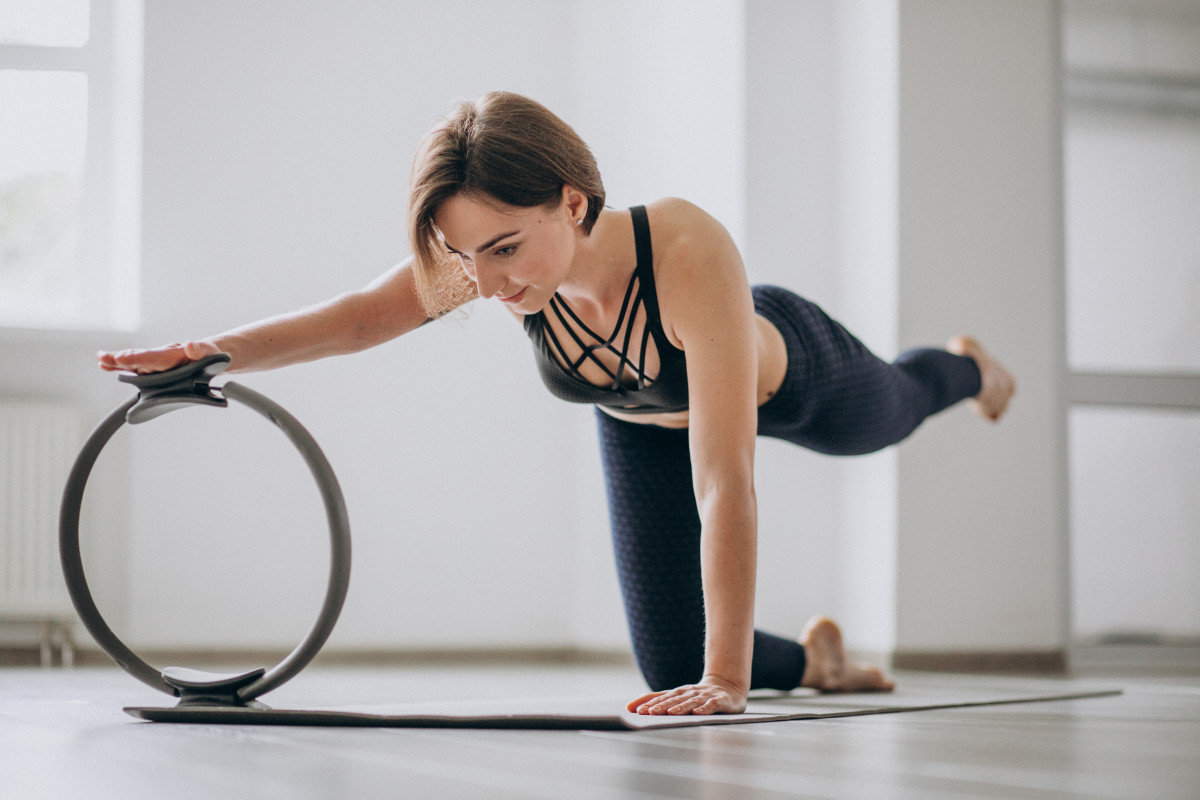Also known as the Pilates barrel and the Pilates ring respectively, are engaging in a dynamic and challenging workout that combines the benefits of both pieces of equipment. Let’s explore this scenario further:
The Pilates Barrel: The Pilates barrel is a specialized piece of equipment designed to enhance flexibility, mobility, and strength through a variety of exercises. Shaped like a barrel or a half-barrel, it offers support and resistance for a range of movements, particularly those that focus on spinal extension and flexion.
The Magic Circle (Pilates Ring): The magic circle, or Pilates ring, is a flexible metal or rubber ring with padded handles. It’s used to add resistance and challenge to Pilates exercises, particularly those targeting the arms, legs, and core muscles. The magic circle helps to engage and strengthen muscles while also promoting proper alignment and control.
Benefits of Using Both: Combining the Pilates barrel with the magic circle offers a comprehensive and dynamic workout experience. The barrel provides support for exercises that require spinal extension, allowing students to safely deepen their stretches and improve flexibility. Meanwhile, the magic circle adds resistance to exercises targeting the arms, legs, and core, helping to build strength and muscle tone.
Example Exercises:
- Spinal Extension: Students can lie back over the barrel and perform exercises such as the Swan or the Seal, which focus on spinal extension and strengthening the back muscles.
- Core Engagement: Placing the magic circle between the legs during exercises like the Hundred or the Roll-Up adds resistance, intensifying the workout for the core muscles.
- Upper Body Strengthening: Using the magic circle for exercises such as the Arm Press or the Side Arm Press helps to strengthen the arms, shoulders, and chest muscles.
Safety Considerations: While the combination of the Pilates barrel and the magic circle can provide an effective workout, it’s essential for students to use proper form and technique to prevent injury. Students should listen to their bodies, work within their limits, and consult with a qualified Pilates instructor if they have any concerns or limitations.
Certainly! The magic circle, also known as the Pilates ring, is a versatile piece of equipment that can be used to add resistance and challenge to a wide range of exercises. Here are some different types of exercises you can do with the magic circle:
- Arm Exercises:
- Arm Press: Hold the magic circle between your palms and press outward against the resistance, engaging the chest and arm muscles.
- Arm Circles: Hold the magic circle with both hands and perform small or large circles, targeting the shoulders and arms.
- Leg Exercises:
- Leg Press: Place the magic circle between your ankles or thighs and squeeze inward against the resistance, targeting the inner thigh muscles.
- Leg Lifts: Place the magic circle around one ankle or thigh while lying on your side and lift the leg against the resistance, targeting the outer thigh and hip muscles.
- Core Exercises:
- Hundred Variation: Hold the magic circle between your hands and extend your arms overhead while performing the Hundred exercise, engaging the core muscles.
- Crunches: Place the magic circle between your knees or thighs and perform crunches, engaging the core muscles while also targeting the inner thighs.
- Back Exercises:
- Back Extension: Lie face down with the magic circle under your hands and lift your chest off the mat, engaging the back muscles.
- Swimming Variation: Hold the magic circle between your hands and feet while performing the Swimming exercise, engaging the back muscles and challenging stability.
- Pilates Mat Exercises:
- Bridge Variation: Place the magic circle between your inner thighs or knees while performing the Bridge exercise, engaging the inner thigh muscles and adding stability.
- Roll-Up Variation: Hold the magic circle between your hands while performing the Roll-Up exercise, engaging the arms and shoulders while also challenging core stability.
- Standing Exercises:
- Squats: Hold the magic circle in front of you at chest height and press inward against the resistance while performing squats, targeting the arms and chest.
- Standing Leg Press: Stand with the magic circle between your ankles or thighs and press inward against the resistance while performing small pulses, targeting the inner thigh muscles.
These are just a few examples of the many exercises you can do with the magic circle. Incorporating this versatile piece of equipment into your workout routine can add variety, challenge, and effectiveness to your exercises, helping you achieve your fitness goals.
Conclusion
Practicing Pilates in the barrel with the magic circle offers a challenging and rewarding workout experience that promotes flexibility, strength, and overall body awareness. By incorporating these pieces of equipment into their practice, students can enhance their Pilates routine and achieve greater fitness and wellness goals.
Discover more from Pilates All Ages
Subscribe to get the latest posts sent to your email.
